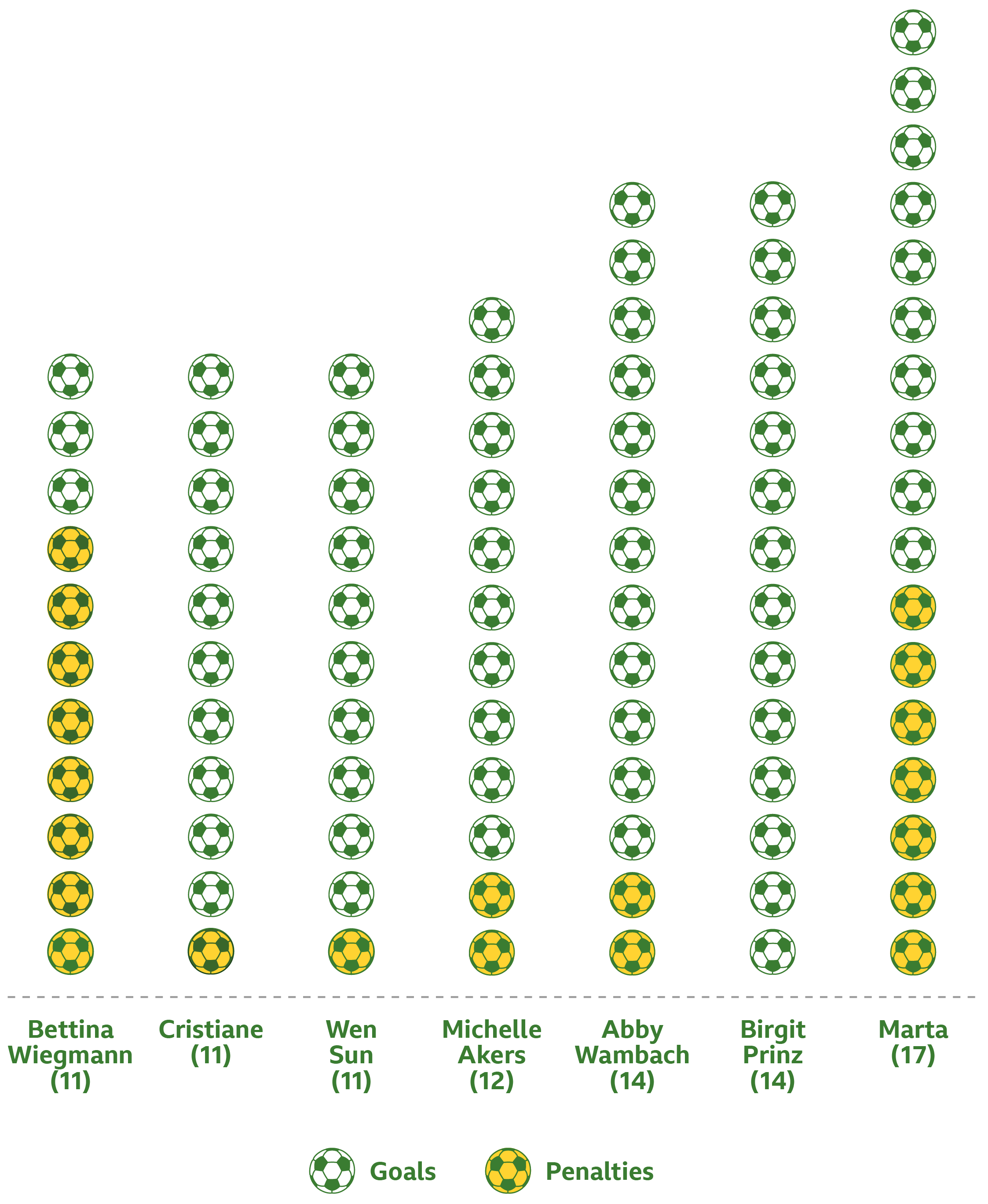Visual guide
to the Women's
World Cup
Key facts surrounding the history
of the competition and a preview
of the 2023 tournament

By Katie Wright & Lee Martin
Published 19 July, 2023

This will be the ninth edition of the Women’s World Cup, which first took place in 1991. That inaugural tournament saw 12 teams compete in China, where the United States won the first of their four world titles.
The 2023 tournament is being jointly hosted by Australia and New Zealand, between 20 July and 20 August. It features 32 nations for the first time, having been expanded from 24 teams, with 64 matches taking place at 10 different venues across nine cities.
The history
Long before the official tournament started in 1991, an unofficial World Cup took place in 1970 in Italy. The English Football Association had banned women's football in 1921, and Uefa and Fifa – the European and world governing bodies - were not interested in investing in the game. Instead, a group of Italian businessmen decided to stage international tournaments as the Federation of Independent European Female Football.
This poster promoted a match between Czechoslovakia and Denmark which ultimately didn't take place, as the Czechs had to pull out of the tournament. The Danes would go on to become champions, beating the host nation Italy 2-0 in the final.

The 2023 hosts
It is the first time the tournament has been hosted by more than one country. New Zealand have played at five previous editions, never getting past the group stages, while Australia have reached the quarter-finals three times in their seven appearances.

History of finishes
Thirty-six nations have taken part since the first Women’s World Cup in 1991. The competition has seen four past champions - the United States (four), Germany (two), Japan (one) and Norway (one). Those teams are among the seven ever-presents, along with Sweden, Brazil and Nigeria. This year will see eight teams make their World Cup debuts - Portugal, the Republic of Ireland, Vietnam, the Philippines, Haiti, Panama, Zambia and Morocco.
Key: Scale of circles equivalent to the number of finishes at each round



Most goals
Brazil striker Marta leads the goalscoring charts at the Women’s World Cup with 17 goals in 20 appearances, which have come at five different tournaments. German striker Birgit Prinz and United States forward Abby Wambach share second spot with 14 goals. The USA’s Michelle Akers, who scored 12 goals in just 13 World Cup matches, holds the record for the most goals scored in a tournament having found the net 10 times in 1991.

Prize money
Teams will receive increased prize money at this year's World Cup, with the winning country set to gain ÂŁ3.4m. Players will receive individual payments ranging from ÂŁ23,000 if they are knocked out in the group stages to ÂŁ208,000 if they win.

Stars to watch
The World Cup has provided the platform for some of the icons in women’s football to become household names. This year will see many returning stars as well as those still looking to prove themselves on the world stage.

Young players to watch
The World Cup is an opportunity for some of the best young players on the planet to make their name. Here are some to look out for:

Returning for more
Three players will be taking part in their sixth World Cup after being selected for this summer’s tournament, having first appeared in the competition in 2003.


The match ball
The design for the 2023 official match ball has taken inspiration from the natural landscapes of host countries Australia and New Zealand.
Called OCEAUNZ – to reflect the coming together of Australia and New Zealand – the ball aims to celebrate the cultures of both host countries and features designs by Aboriginal artist Chern’ee Sutton and Maori artist Fiona Collis.

The trophy
The current trophy was first awarded at the third World Cup, in the USA in 1999. Designed by William Sawaya from Milan firm Sawaya and Moroni, it is 47cm (19 in) tall and weighs 4.6kg (10 lb).
It is made from gold-plated brass with a base made from candeias granite. As with the men's trophy, there is a gold disk underneath which lists the winners.

The final
Stadium Australia, which will host Australia’s opening game of the tournament and three knockout games, will also be the venue for the final on 20 August. The country’s national stadium, in the Sydney Olympic Park, was originally built to host the 2000 Olympic Games. It has a capacity of almost 70,000 for the Women’s World Cup.
Completed in 1999 and costing ÂŁ357m, the stadium can currently be configured as a rectangle or an oval, allowing it to cater to a variety of sports and music performances. Plans in 2017 to completely rebuild the stadium were diluted in 2018 in favour of a major refurbishment, but were then scrapped altogether in 2020 because of the Covid pandemic.
Credits
Words by Katie Wright
Main Illustration by Selman Hoşgör
Illustration of Marta by Stan Chow
Data Visualisations by Lee Martin
Images by Getty Images
Sub Edited by Richard Dore
More Long Reads

Get to know the England World Cup Squad
łÉČËżěĘÖ Sport takes a closer look at those who have made it on to the plane

Blue v Red: Battle of Manchester
Journey through the rivalry between Manchester City and Manchester United